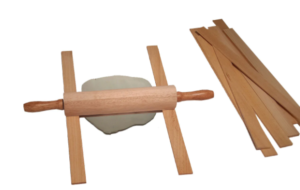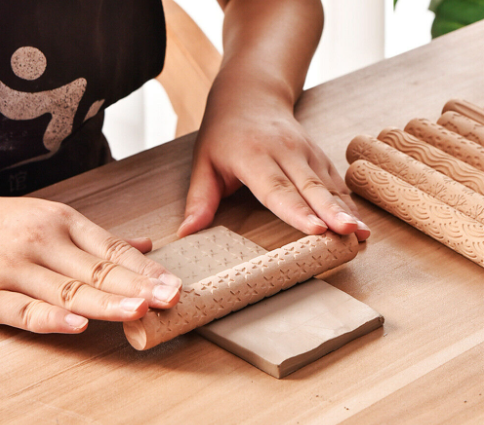Table Of Contents
- 1 Unveiling the Mystery: Will Clay Stick to Wood?
- 1.1 Clay’s Diverse Nature: A Spectrum of Adhesive Properties
- 1.2 Beyond Clay: The Role of Surface Preparation
- 1.3 Deciphering the Code: The Meaning of “Clay Sticks to Wood”
- 1.4 Embracing the Versatility: A World of Possibilities
- 1.5 Bridging the Gap: Effective Methods for Attaching Clay to Wood
- 1.6 Adhesive Arsenal: Bonding Clay to Wood with Confidence
- 1.7 Beyond Glue: Embedding Techniques for Enhanced Adhesion
- 1.8 Surface Textures: Enhancing the Bond and Adding Artistic Flair
- 1.9 From Theory to Practice: A Step-by-Step Guide
- 1.10 The Enduring Bond: Wrapping Up Clay and Wood
- 1.11 Key Takeaways:
- 1.12 Frequently Asked Questions (FAQs):
- 1.13 Q: What type of wood is best for attaching clay to?
- 1.14 Q: How long does it take for clay to dry on wood?
- 1.15 Q: What can I do if the clay cracks after drying?
- 1.16 Q: Where can I find more information and inspiration for clay and wood projects?
- 1.17 Conclusion:
Unveiling the Mystery: Will Clay Stick to Wood?
The question of whether clay will stick to wood is a common one among artists and hobbyists alike. Whether you’re crafting a charming clay sculpture to adorn your home or creating a unique functional object, understanding how clay interacts with wood is crucial for achieving a successful and lasting work of art.
In this first session, we’ll embark on a journey to uncover the answer to this intriguing question. We’ll delve into the factors that influence the adhesion between clay and wood, exploring the diverse types of clay and their adhesive properties, and the various surface preparations that can enhance the bond.
Clay’s Diverse Nature: A Spectrum of Adhesive Properties
Not all clays are created equal when it comes to sticking to wood. Their natural composition and properties significantly impact their adhesiveness. Here’s a closer look at some popular types of clay:
- Air-dry clay: This readily available and versatile clay possesses a natural stickiness, making it a popular choice for adhering to wood. However, its strength varies depending on the brand and formula.
- Polymer clay: This oven-bake clay offers a strong bond to wood, particularly when baked directly on the surface. Its flexibility allows for shaping and sculpting around intricate wood features.
- Earthenware and stoneware: These clays require additional support to adhere to wood due to their lower natural stickiness. Applying an adhesive or embedding the clay into the wood can create a secure bond.
Beyond Clay: The Role of Surface Preparation
The surface of both the clay and the wood play a critical role in achieving a strong bond. Here are some key preparation steps:
- Cleanliness: Ensure both surfaces are free of dust, dirt, and oils. Cleaning with a damp cloth or using a mild abrasive can improve adhesion.
- Roughening the wood: Sanding the wood surface creates a textured surface that the clay can grip onto, resulting in a stronger bond.
- Priming: Applying a primer specifically designed for wood can increase the surface’s porosity, enhancing the adhesion of the clay.
In the next session, we’ll delve deeper into the specific techniques and methods for attaching clay to wood, exploring various adhesives, embedding techniques, and best practices for achieving a long-lasting and visually appealing bond.

Deciphering the Code: The Meaning of “Clay Sticks to Wood”
In our previous session, we ignited the exploration of clay’s adhesion to wood. Now, we delve deeper into the essence of the statement “clay sticks to wood.” This seemingly straightforward phrase holds a deeper meaning, encompassing a complex interplay of factors that determine the strength and longevity of the bond.
Beyond a Simple Adhesion: A Look Beyond the Surface
The phrase “clay sticks to wood” encapsulates not just physical adhesion but also a nuanced interaction between the materials. This interplay involves:
- Surface properties: The texture, porosity, and cleanliness of both the clay and the wood significantly impact the bond’s strength. Rougher surfaces and increased porosity enhance adhesion, while impurities can hinder it.
- Clay composition: Different types of clay possess varying degrees of inherent stickiness. Air-dry clay, for instance, naturally adheres well, while earthenware may require additional support.
- Moisture content: The ideal moisture content of the clay is crucial. Clay that is too dry crumbles readily, while overly wet clay can cause warping or shrinkage.
- Application techniques: The method used to attach the clay to the wood is paramount. Pressing firmly, embedding the clay, and using appropriate adhesives contribute to a secure and durable bond.
Embracing the Versatility: A World of Possibilities
The statement “clay sticks to wood” opens a world of creative possibilities for artists and crafters. It empowers them to:
- Craft unique sculptures and art pieces: Combining the natural beauty of wood with the moldable nature of clay allows for the creation of stunning and original artwork.
- Design functional objects: From decorative bowls and mugs to intricate jewelry, clay adhering to wood facilitates the creation of functional objects with both artistic merit and practical utility.
- Explore diverse techniques: Artists can experiment with various application techniques, adhesives, and surface textures to achieve different visual effects and enhance the overall impact of their creations.
In the next session, we’ll delve into the practical aspects of adhering clay to wood. We’ll explore specific methods, techniques, and materials to empower you to confidently bring your artistic vision to life.

Bridging the Gap: Effective Methods for Attaching Clay to Wood
Having unveiled the intricacies of clay’s adhesion to wood, we now embark on the practical side of the equation. This session delves into the specific methods, techniques, and materials you need to confidently bridge the gap between these two versatile materials.
Adhesive Arsenal: Bonding Clay to Wood with Confidence
Adhesives play a crucial role in ensuring a strong and long-lasting bond between clay and wood. Here are some popular options:
- Craft glue: This versatile adhesive is readily available and provides a good bonding strength for lighter clay projects.
- Epoxy glue: Offering superior strength and durability, epoxy is ideal for heavier clay objects and those subjected to regular use.
- Liquid polymer clay: This versatile material acts as both a sculpting medium and an adhesive, offering a seamless transition between clay and wood.
- Specialized wood adhesives: Certain wood adhesives specifically formulated for bonding clay provide a strong and reliable bond.
Beyond Glue: Embedding Techniques for Enhanced Adhesion
Embedding clay into the wood offers an additional layer of security for your creations. Here are two common techniques:
- Carving grooves: Using a sharp tool, create grooves or indentations in the wood surface. Press the clay into these grooves to create a strong mechanical bond.
- Drilling holes: Drill small holes in the wood and insert wire or dowels dipped in glue. Sculpt the clay around the wire or dowels, creating a secure and reinforced connection.
Surface Textures: Enhancing the Bond and Adding Artistic Flair
Texturing the wood surface before applying clay can significantly improve the bond’s strength. Here are some popular methods:
- Sanding: Sanding the wood surface creates a rougher texture that the clay can grip onto, enhancing adhesion.
- Scoring: Using a sharp tool to create score lines or cross-hatching patterns on the wood surface increases its surface area and improves the bond.
- Textured mediums: Applying a textured medium, such as gesso or acrylic paste, can provide a base for the clay to adhere to, adding visual interest to the finished piece.
From Theory to Practice: A Step-by-Step Guide
Here’s a simplified guide to effectively attaching clay to wood:
- Prepare the wood: Clean and sand the wood surface.
- Prepare the clay: Ensure the clay is at the appropriate moisture content.
- Apply adhesive: Choose a suitable adhesive and apply it to both the wood and the clay surface.
- Attach the clay: Press the clay firmly onto the wood, ensuring good contact.
- Secure the bond: Use additional techniques like embedding or wrapping with wire for heavier or functional objects.
- Allow to dry: Follow the drying instructions for your chosen clay and adhesive.
- Finish and embellish: Once dry, you can sand, paint, or embellish your creation as desired.
By understanding the available methods and techniques and carefully implementing them, you can confidently adhere clay to wood and create unique and captivating artistic expressions.
The Enduring Bond: Wrapping Up Clay and Wood
Having embarked on a captivating exploration of clay’s adhesion to wood, we reach the culmination of our journey. This final session summarizes key takeaways, addresses frequently asked questions, and provides valuable resources to further your artistic endeavors with this rewarding technique.
Key Takeaways:
- Clay can adhere to wood, but the strength of the bond depends on various factors, including the type of clay, surface preparation, moisture content, and application method.
- Different types of clay, such as air-dry clay, polymer clay, and earthenware, possess varying degrees of natural stickiness and require different approaches for a strong bond.
- Proper surface preparation, including cleaning, roughening the wood, and using a primer, can significantly enhance the adhesion between clay and wood.
- Various adhesives, including craft glue, epoxy glue, and liquid polymer clay, offer reliable options for securely attaching clay to wood.
- Embedding techniques, such as carving grooves and drilling holes, can provide additional support and reinforcement for heavier clay objects.
- Texturing the wood surface through sanding, scoring, or applying textured mediums increases the surface area and improves the bond’s strength.
Frequently Asked Questions (FAQs):
Q: What type of wood is best for attaching clay to?
A: Most types of wood, such as plywood, balsa wood, and pine, can be used for clay projects. However, it’s important to choose a wood that is dry, stable, and free of warping.
Q: How long does it take for clay to dry on wood?
A: The drying time depends on the type of clay, the thickness of the application, and the surrounding humidity. Air-dry clay typically takes 24-48 hours to dry completely, while polymer clay needs to be baked in an oven.
Q: What can I do if the clay cracks after drying?
A: Minor cracks can be repaired with a small amount of water and smoothed with a damp brush. For larger cracks, you may need to remove the clay and re-attach it.
Q: Where can I find more information and inspiration for clay and wood projects?
A: Numerous online resources and websites offer tutorials, tips, and project ideas for working with clay and wood. Additionally, craft stores and libraries often have books and magazines dedicated to these mediums.
Conclusion:
The enduring bond between clay and wood opens a world of artistic possibilities. By understanding the factors influencing adhesion and mastering various techniques, you can create stunning sculptures, innovative functional objects, and unique artistic expressions. Remember, experimentation, practice, and a passion for artistic exploration are the keys to unlocking the full potential of this captivating material combination.
This concludes our exploration of the relationship between clay and wood. We hope this information has been informative and inspiring. Please feel free to ask any further questions you may have and keep exploring the fascinating world of clay and wood artistry.

1 thought on “Will Clay Stick To Wood”